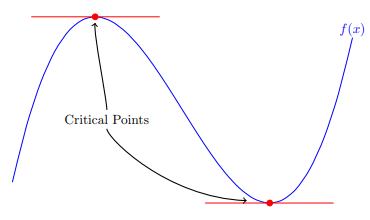FINDING CRITICAL POINTS
Subscribe to our ▶️ YouTube channel 🔴 for the latest videos, updates, and tips.
To find critical numbers, we have to use steps given below.
Step 1 :
Find the first derivative.
Step 2 :
Equate the first derivative to 0.
Step 3 :
Solve for the variable. From this, we can understand that slope will be zero at these positions.

Use Calculus to find the CRITICAL POINTS of each of the following functions:
Problem 1 :
f(x) = 3x2 - 5x + 1
Solution :
Let f(x) = 3x2 - 5x + 1
f'(x) = 6x - 5 + 0
f'(x) = 6x - 5
f'(x) = 0
6x - 5 = 0
2x = 5
x = 5/6
The curve will flatten at the x-coordinate 5/6. So, the critical number is at x = 5/6.
Problem 2 :
f(x) = x4 + 2x3 - 1
Solution :
f(x) = x4 + 2x3 - 1
f'(x) = 4x3 + 2(3x2) - 0
f'(x) = 4x3 + 6x2
f'(x) = 0
4x3 + 6x2 = 0
2x2(2x + 3) = 0
2x2 = 0 and 2x + 3 = 0
x = 0 and x = -3/2
So, the critical points are 0 and -3/2
Problem 3 :
f(x) = (8x - 16) / x2
Solution :
f(x) = (8x - 16) / x2
Using quotient rule, we find the first derivative.
|
u = 8x - 16 u' = 8(1) - 0 u' = 8 |
v = x2 v' = 2x |
f'(x) = (vu' - uv') / v2
= (x2(8) - (8x - 16)(2x)) / (x2)2
= (8x2- (16x2 - 32x)) / x4
= (8x2- 16x2 + 32x) / x4
f'(x) = (-8x2 + 32x) / x4
f'(x) = 0
(-8x2 + 32x) / x4 = 0
-8x2 + 32x = 0
-4x(2x - 8) = 0
4x = 0 and 2x - 8 = 0
x = 0 and 2x = 8 ==> x = 4
So, the critical points are 0 and 4.
Problem 4 :
f(x) = 2x + 3x2/3
Solution :
f(x) = 2x + 3x2/3
f'(x) = 2(1) + 3(2/3)x(2/3) - 1
f'(x) = 2 + 2x(-1/3)
f'(x) = 0
2 + 2x(-1/3) = 0
2x(-1/3) = -2
x(-1/3) = -1
1/∛x = -1
∛x = -1
x = -1
So, the critical point is at x = -1.
Problem 5 :
f(x) = x4 - 2x2 + 3
Solution :
f(x) = x4 - 2x2 + 3
f'(x) = 4x3 - 2(2x) + 0
= 4x3 - 4x
f'(x) = 0
4x3 - 4x = 0
4x(x2 - 1) = 0
4x = 0 and x2 - 1 = 0
x = 0 and x2 = 1
x = 1 and -1
So, the critical points are -1, 0 and 1.
Subscribe to our ▶️ YouTube channel 🔴 for the latest videos, updates, and tips.
Recent Articles
-
Finding Range of Values Inequality Problems
May 21, 24 08:51 PM
Finding Range of Values Inequality Problems -
Solving Two Step Inequality Word Problems
May 21, 24 08:51 AM
Solving Two Step Inequality Word Problems -
Exponential Function Context and Data Modeling
May 20, 24 10:45 PM
Exponential Function Context and Data Modeling